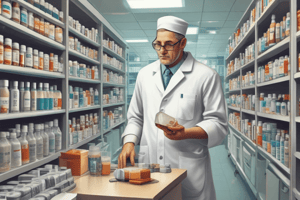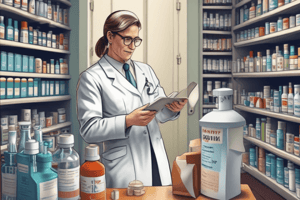Podcast
Questions and Answers
Which of these are components of the USP?
Which of these are components of the USP?
- USP General Notices
- Monographs
- USP General Chapters
- All of the above (correct)
What is the purpose of USP Pharmaceutical Compounding - Sterile Preparations?
What is the purpose of USP Pharmaceutical Compounding - Sterile Preparations?
It provides standards to prevent harm that could occur from microbial, chemical, or physical contamination; incorrect strength; or inappropriate quality of compounded sterile preparations for human and animal patients.
Immediate Use CSPs can only involve the mixing of more than 3 sterile manufactured ingredients.
Immediate Use CSPs can only involve the mixing of more than 3 sterile manufactured ingredients.
False (B)
What characterizes Low Risk CSPs?
What characterizes Low Risk CSPs?
What are Medium Risk CSPs?
What are Medium Risk CSPs?
High Risk CSPs are mixed using sterile starting ingredients only.
High Risk CSPs are mixed using sterile starting ingredients only.
What must be included in USP 797 Training?
What must be included in USP 797 Training?
What are Primary Engineering Controls (PECs)?
What are Primary Engineering Controls (PECs)?
What constitutes a Cleanroom Suite in Secondary Engineering Controls (SECs)?
What constitutes a Cleanroom Suite in Secondary Engineering Controls (SECs)?
Anteroom that opens into a positive pressure buffer room(s) qualifies as ____.
Anteroom that opens into a positive pressure buffer room(s) qualifies as ____.
Match the USP 797 Minimum ISO Classifications:
Match the USP 797 Minimum ISO Classifications:
The buffer room must be more positive than the anteroom.
The buffer room must be more positive than the anteroom.
How often must PECs and SECs be certified?
How often must PECs and SECs be certified?
The first step in garbing & hand hygiene is to put on ____ covers.
The first step in garbing & hand hygiene is to put on ____ covers.
Flashcards are hidden until you start studying
Study Notes
USP Components
- USP General Notices outline basic information, including dosage forms and temperature requirements.
- USP General Chapters detail established procedures, methods, and practices, such as USP 795, 797, and 800.
- Monographs offer specific formulations or compounds, with approximately 200 found in the USP compendium.
- Hierarchy of specificity: Monographs > General Chapters > General Notices.
USP Pharmaceutical Compounding - Sterile Preparations
- Standards exist to prevent harm from contamination and incorrect preparation of compounded sterile preparations (CSPs).
- CSPs encompass drugs, biologics (such as injections and infusions), ophthalmics, tissue implants, and others that require sterility.
Categories of CSPs - Immediate Use
- Immediate use CSPs are compounded outside standard facilities due to urgency.
- Limited to a maximum of three sterile ingredients and two entries into any one container.
Categories of CSPs - Low Risk
- Low risk CSPs are prepared in a compliant area for a single patient.
- Example: Reconstituting a cefazolin vial for IV administration.
Categories of CSPs - Medium Risk
- Medium risk CSPs are prepared in bulk for multiple patients or complex mixtures.
- Example: Compounding 10 units of antibiotic syringes.
Categories of CSPs - High Risk
- High risk CSPs involve non-sterile ingredients or non-compliant environments.
- Example: Mixing alum irrigation from an active pharmaceutical ingredient (API).
USP 797 Training
- Requalifying training includes written tests, media fill tests, and gloved fingertip tests.
- Testing frequency is every 6 months for high-risk and every 12 months for medium or low-risk CSPs.
- Initial compounders must complete three sets (six plates) without contamination; requalification requires only one set (two plates).
USP 797 - Primary Engineering Controls (PECs)
- PECs are devices used for CSP preparation, including laminar airflow workbenches and biological safety cabinets.
- Must maintain an ISO 5 or cleaner air quality.
USP 797 - Secondary Engineering Controls (SECs)
- SECs are the rooms housing PECs, which include cleanroom suites and segregated compounding areas (SCAs).
- Cleanroom suites comprise a positive pressure anteroom and one or more buffer rooms.
USP 797 - SECs & Minimum ISO Classification
- Anterooms with positive pressure buffer rooms require ISO 8 classification.
- Negative pressure rooms require ISO 7 classification.
- SCAs and containment SCAs are not required to be ISO classified.
USP 797 - Pressure Gradients Between Rooms
- Buffer room must have a pressure of 0.020" greater than the anteroom.
- Anteroom pressure must be 0.020" higher than the general area.
- No pressure gradient is required for SCAs.
USP 797 - Certification of PECs and SECs
- Certification of PECs and SECs must be conducted every six months to ensure compliance.
USP 797 - Garb & Hand Hygiene
- Proper garb includes head/hair covers, masks, and shoe covers in the anteroom or SCA.
- Hand hygiene procedures must be followed before entering clean areas.
- Steps: step into the clean side, don a gown, apply alcohol-based rub, and put on sterile gloves.
Studying That Suits You
Use AI to generate personalized quizzes and flashcards to suit your learning preferences.




